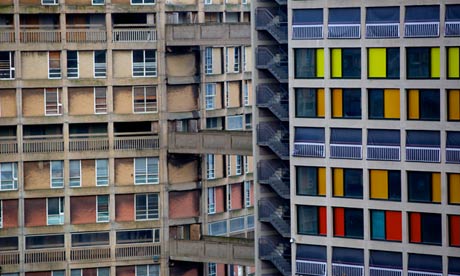This website uses cookies
This website uses cookies to enable it to function properly and to analyse how the website is used. Please click 'Close' to accept and continue using the website.



Just been looking at all the on line comments following this article by Peter Walker. The article itself had some interesting quotes from new residents, but was disappointingly unanalytical and didn’t really address the complexities and controversies surrounding the refurbishment (or what ever word is appropriate for what is being done–certainly not conservation–I’d go for reinvention–see my piece in C20 Magazine). Good to see that the percentage of “it’s ugly” /”how can anyone seriously like that concrete monstrosity”/”the world has gone crazy if this is what we are preserving” rants continues to go down . These things are a very useful barometer of how public perceptions are shifting–(and yes I do know that Guardian readers are not representative of the public at large!)
I was pleased to note just how many people had been promoted to contribute, and especially by these:
“Everybody who had any experience of Park Hill flats seemed to really like them, spacious, well designed and made, stunning views. The deterioration was the result of policies implemented by the same council which produced David Blunkett.”
“The major problems were caused by a lack of maintenance lifts, and flats as well of the withdrawal of the milk round and closure of shops and the school. Park Hill was designed as a community and actually worked well for the fist decade or so untill de-industrialization took hold.”
“I have been living in a district consisting solely of blocks of flats in Varna, Bulgaria. This district, Chayka, is the most sought after area in the city. There are plenty of green spaces and sports facilities, a massive seaside park 5 minutes away, a beach 10 minutes away, and the city centre is 20 minutes walking distance. There is virtually no street crime and most people are good neighbours.”
“I can equally point you to a complex of flats in my hometown of Stockport, owned by the council, which are among the highest demand housing in the town, not least because of the cheap heating, concierge system, lack of children, and easy access to the town centre shops.”
“I was a resident caretaker on two separate estates during the 80’s one in Scotland, one in England. The majority of people on these estates were ordinary people trying to live a normal life, but there was a minority of people who made life difficult and caused problems, the police and the council couldn’t care less so the decent tenants (the majority) were left to suffer at the hands of a minority. Things have changed in the last couple of decades, security doors, CCTV cameras and 24 hr caretaking has improved life on these estates, however what these people really need are jobs.”
Of course if everyone agreed, we could just shut up shop and close the C20—but unsurprisingly there was a fair mix of opposition including these
“The term ‘Brutalist’ is very apt, but why it’s celebrated and why some of the structures which fall under this term have been listed, is astonishing. Humans need easy access to nature, even if it’s just walking out your back door to a tiny garden! This structure should have been knocked down – it’s what the people of Sheffield wanted, but the arrogance of a handful of people in a world a hundred times removed from ordinary folk said no. Anyone who can look at this building from a distance and see any kind of beauty, is clearly lacking in soul. The term ‘Brutalist’ is very apt, but why it’s celebrated and why some of the structures which fall under this term have been listed, is astonishing. Humans need easy access to nature, even if it’s just walking out your back door to a tiny garden! his structure should have been knocked down – it’s what the people of Sheffield wanted, but the arrogance of a handful of people in a world a hundred times removed from ordinary folk said no. Anyone who can look at this building from a distance and see any kind of beauty, is clearly lacking in soul.” bbmatt
and
“Knock down all brutalist rubbish, now.” MaximusG
This was our response:
What the rebirth of Park Hill (see Guardian Mon 31st December, p.3), shows is that there is nothing intrinsically infamous or unlovable about Brutalist architecture, as C20 Society, and growing numbers of other fans, have long argued . The big problem is finding the funds to refurbish buildings, which in the most part are owned by local authorities and have been neglected for decades. It was only by selling to the private sector that Park Hill could be saved, and in order to give it a new future it has been very heavily made over and rebranded. It would have been much better in conservation terms to have done a less drastic job, certainly improving the thermal performance and the security of the Estate, but not replacing practically all the carefully selected original materials both inside and out. This would also have cost less, been better for the environment, and allowed it to continue as social housing (arguably crucial to maintaining its historic interest).
All three of the Brutalist buildings Peter Walker lists as currently threatened, could be saved either by selling to the private sector, or (far preferably) by making changes to allow local authorities to be able to put together realistic funding packages to sensitively upgrade and maintain them. Without this we are rapidly losing a whole chapter of our architectural history, and moreover wasting money, disrupting established communities and doing unnecessary harm to the environment.

Become a C20 member today and help save our modern design heritage.
Comments